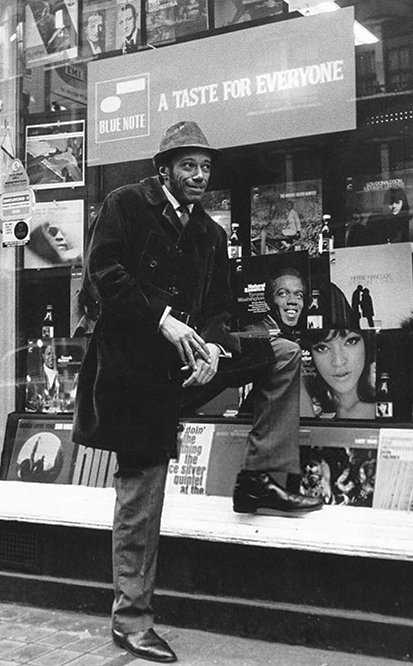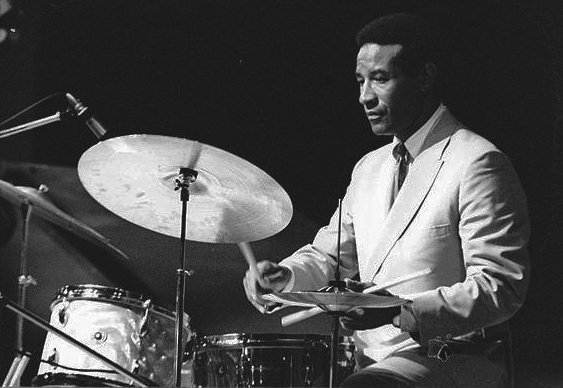Hank Mobley (saxo tenor), Wynton Kelly (piano), Paul Chambers (contrabajo) y Art Blakey (batería). Extraído del álbum Soul Station (1960) de Hank Mobley.
Especialmente importantes en el desarrollo del hard bop fueron dos temas grabados por el pianista Horace Silver: «The Preacher» y «Señor Blues», que ejemplifican la sencillez de la estructura armónica sobre la que se realizan los solos, mucho más elaborados. Los músicos de este estilo eran en su mayoría de raza negra y no estaban de acuerdo con el concepto que los artistas blancos que tocaban cool jazz tenían del swing. Su ritmo poderoso no tenía nada que ver con las técnicas sofisticadas utilizadas por los músicos de cool jazz. El saxofonista alto Al Cohn era una excepción en el hard bop por ser blanco y en una de sus grabaciones aparecían Silver y el batería Max Roach. Horace Silver tocaba dentro de la tradición del blues, en contraposición al sonido delicado que los pianistas californianos extraían del mismo instrumento.
Especially important in the development of hard bop were two songs recorded by pianist Horace Silver: “The Preacher” and “Señor Blues”, which illustrate the simplicity of the harmonic structure on which the much more elaborated solos are performed. Musicians in this style were mostly black and didn’t agree with white cool jazz artists’ concept of swing. Their powerful rhythm had nothing to do with the sophisticated techniques used by cool jazz musicians. Alto saxophonist Al Cohn was an exception in hard bop because he was white and one of his recordings featured Silver and drummer Max Roach. Horace Silver played in the blues tradition, as opposed to the delicate sound that Californian pianists brought out of the same instrument.

Cabe señalar la aparición del virtuoso trompetista Clifford Brown, que aunque carecía de los infinitos recursos de Dizzy Gillespie o la inspiración atemperada de Miles Davis, dominaba el sonido y la ejecución de su instrumento de manera inigualable. En el hard bop, la composición y los arreglos cobraron mayor importancia, e incluso cuando los grupos interpretaban versiones de temas antiguos, introducían en ellas novedades interesantes. Predominaban los tiempos medios, pero incluso en los más rápidos, las improvisaciones eran controladas y serenas. En particular, el batería Max Roach no se limitaba a marcar el tiempo, sino que empezó a añadir efectos dinámicos sutiles y una tensión lírica influída por el blues.
It’s worth noting the arrival of virtuoso trumpeter Clifford Brown, who although lacking Dizzy Gillespie’s infinite resources or Miles Davis’ tempered inspiration, mastered the sound and execution of his instrument in an unequalled way. In hard bop, composition and arrangements became more important, and even when groups performed versions of old songs, they introduced interesting new features. Mid tempos predominated, but even in the fastest ones, improvisations were controlled and serene. In particular, drummer Max Roach didn’t just keep time, but began to add subtle dynamic effects and a blues-influenced lyrical tension.

Tras una breve introducción de Kelly, entra Mobley a tocar el tema y a continuación comienza su solo con frases muy melódicas basadas en el blues. Sigue tocando lentamente, como si estuviera manteniendo con alguien una larga conversación. Después llega Kelly con mucho swing tocando también un solo simple y relajado. A continuación aparece Chambers con un discurso cómodo y sosegado acompañado por el piano y la batería, y finalmente el grupo reexpone el tema.
After a brief introduction by Kelly, Mobley enters to play the theme and then begins his solo with very melodic blues-based sentences. He keeps playing slowly, as if he is having a long conversation with someone. Then Kelly arrives with a lot of swing also playing a simple and relaxed solo. Next Chambers comes in with a comfortable and calm speech supported by piano and drums, and finally the group re-exposes the theme.

Translated with the help of DeepL
℗ Blue Note Records


Si te ha gustado el tema, quizá querrás escuchar también los anteriores de este álbum:
If you liked the track, you might also want to listen to the previous ones on this album:

